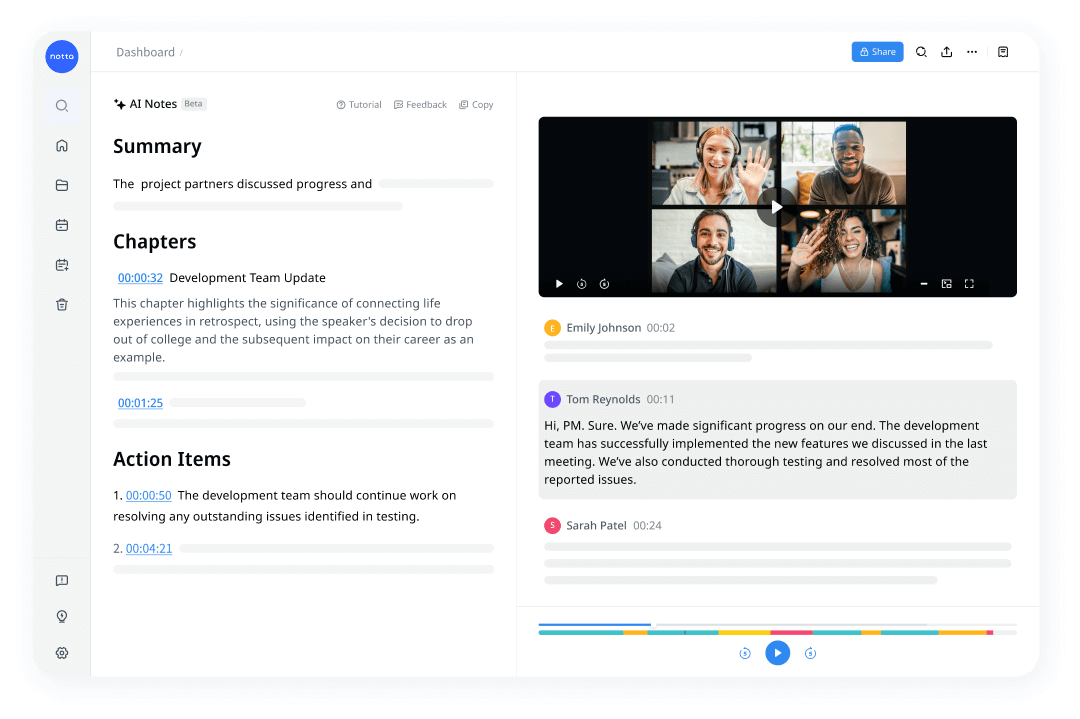
How to Run Team Check-In Meetings: A Guide for Managers
Unlock the power of AI — Notta's meeting assistant records, transcribes and summarizes meeting minutes with one click.
For managers, keeping a team together while ensuring everyone is productive is a top priority. One-on-one meetings are often used to facilitate this goal. But there’s yet another technique that works - team check-in meetings.
While check-in meetings are a great way for managers to stay up to date with projects that the team is working on, challenges they may be facing, and progress made, they sometimes go over and beyond, thus leading to micromanaging. However, most employees detest this.
Finding a balance between frequent check-ins with the team and micromanaging is an extreme sport many managers have to deal with. You’ll get the hang of it after reading through this post.
What is a check-in meeting
A check-in meeting is a regular meet-up between team members to discuss progress, updates, and challenges related to ongoing projects or tasks.
From the manager's perspective, check-ins are a way for them to touch base with employees to know the progress of their work, challenges they might be facing, and any suggestions they may have for improving the quality of the team’s work.
On the other hand, employees value check-in meetings because they can air their opinions on some issues. They can also get feedback and suggestions from the manager and the rest of the team on their deliverables.
Generally, the purpose of check-in meetings is to keep the team on the same page. It also sort of reinvigorates team members to collaborate better and work towards the same goals.
How often should you hold a check-in meeting?
There’s a thin line between checking in and micromanaging. But the questions often raised are “How often should I check in with my team?” “When does it become too often, thus leading to micromanaging?”
Here’s the thing. It mostly depends on your team’s needs and size. For smaller teams, checking in weekly will suffice. Because the team is small, communication may not really be a challenge. Thus, daily check-ins may be doing too much.
Meanwhile, large organizations might benefit more from daily check-ins because of the team’s size. Keeping in touch should be done more frequently to ensure everyone is on the same page.
Another factor to consider is the work environment. Daily check-in is more advisable for a team that works remotely because in-person interaction is low. In contrast, a team that works physically in an office should do fine with weekly check-in meetings.
Why check-in meetings are important for a team
What are the benefits of check-in meetings? How do they affect team collaboration and efficiency? Let’s find out.
1. Improves team collaboration
Communication is vital in any type of relationship, professional or informal. In a work environment, managers and team members must learn to keep in touch by communicating regularly.
Having scheduled one-on-one meetings is not enough. The team needs to come together to interact and bond over work. It makes it easier for them to work together on projects. It also fosters a culture of rendering help to each other, and the domino effect is an improved collaboration across the team.
2. Builds valuable relationships
When teams meet regularly, it creates a sense of togetherness. While one-on-ones with managers only improve the relationship between the manager and the individual members of the group, check-ins strengthen the bond of the team members as a whole.
Teammates can grow fond of each when they work together on several projects, and regular meetings often foster this. Check-ins ease the tension associated with work and can help members feel more comfortable interacting with each other. That is how valuable relationships are built.
3. Creates a sense of accountability
By sharing the progress of your work with your manager and the rest of the team, you’re making yourself available for evaluation. Check-in meetings make this possible, which is why it can create a sense of accountability within the group.
Accountability is a valuable tool in any organization. When employees know they’ve to report to the team on the progress of their work, it will motivate them to put in the effort to deliver good quality.
4. Helps identify potential challenges
Projects come with their risk. And the ability of a project manager to identify potential risks and create plans to avoid them is necessary for the project's success.
Managers must learn to identify potential challenges that may hamper the productivity of their team or the quality of their work.
Interestingly, check-in meetings allow the team to detect certain risks and find ways to mitigate them.
5. Fosters effective goal-setting and prioritization
During check-in meetings, managers can brief the team about new goals and brainstorm on how to achieve the goals. This makes it easier for employees to know what to prioritize.
Why is this so important? Managers and employees can get swamped with day-to-day activities. Meeting regularly to discuss what’s important and evaluating progress on tasks can inspire focus and direction within the team.
Notta offers the most integrated AI meeting notes, summaries, and action items so nothing gets missed.
Items to include in a check-in meeting
Check-in meetings typically follow this format:
Icebreakers
Your check-in meeting should begin with icebreakers. It’s an excellent way to ease into the crux of the meeting. Icebreakers are basic interactions used to build rapport and get everyone active for the session.
Just anything could be used as an icebreaker. It may be a polite joke or funny comment. Alternatively, team members could just discuss basic things like how their weekends went or how their week was going. If it’s the first meeting after a holiday season, team members can chat about how they spent the holiday.
The idea behind icebreakers is just to prepare the atmosphere by making everyone feel comfortable.
Performance review
This is an integral part of check-in meetings. The manager often spearheads this section by asking about the progress on the task each team member is working on. Questions regarding client feedback, challenges, and suggestions are usually raised here.
This review aims to measure the team’s performance against the client's and management’s expectations to know if the team is doing well or not. Before now, you would have set metrics. Then, you would base your evaluation on these metrics.
Brainstorming session
After reviewing performance, the team can plan for current and upcoming projects, if any. Every member of the team is expected to participate in this session. You can share tasks accordingly for members to work on.
If there are recommendations for improving team performance, now is the right time to introduce them. Solutions to the challenges raised under performance review should be discussed. This part of the check-in meeting often takes more time than others because it involves planning and exchanging ideas.
Summary
In this section, a summary of all that has been discussed is highlighted. Members or managers emphasize vital points and reiterate tasks assigned to each individual.
Important information like deadlines will equally be restated for further emphasis. The aim of this item is to ensure that everyone understands the key takeaways and is on the same page.

How to run an effective check-in meeting
Because check-in meetings are typically shorter than the usual team meetings, managers sometimes fail to plan for them. This may become disastrous and a simple waste of time if no clear agenda for the meeting is determined before time.
These points below will provide guidance on holding effective check-in meetings:
1. Set goals
Why do you want to have check-in meetings? What do you aim to achieve?
It is crucial to have a purpose for your check-in meetings. A saying goes, “Where the purpose of a thing is not known, abuse is inevitable.” Set clear goals to avoid abuse of check-in meetings by both employers and employees.
It could be to improve communication within your team or enhance team collaboration. Whichever is it, discuss it with your team so you can all have the same goal in mind.
2. Determine the meeting cadence
A meeting cadence is how frequently you hold a meeting. Determine how often you want your check-ins to be. In determining that, consider the project's nature and the team's size.
You can also discuss with the team to know how often they want to meet. The cadence can be adjusted from time to time to suit the present need.
Also, aim to meet at a time that works for everyone. Choose a convenient time for everyone to actively participate with interest and without distractions.
3. Create a meeting agenda and stick to it
Don’t start any meeting without having a clear agenda for it. Determine what items you want to include in your meeting agenda and, where feasible, share with the rest of the team to prepare their minds.
Most importantly, stick to this agenda. The ideal check-in meeting is brief and straight to the point. Without an agenda, achieving this may be difficult. Deviating from the agenda will contribute to this difficulty.
4. Encourage participation and seek feedback
Ensure that there is broad participation across the team. No one should be left out. Give each person the chance to share their ideas and suggestions.
Don’t forget to seek feedback from team members on how the check-in meetings can be improved. This is to ensure that they’re effective and it’s a good experience for everyone.
5. Adapt to remote work
If your team is working remotely, leverage video conferencing tools like Zoom and meeting note-taker to conduct virtual check-in meetings. Ensure that all participants have access to the necessary technology and resources.
6. Conclude with key takeaways
If an employee attends a check-in meeting and leaves feeling more confused than he was at the start, then something is wrong somewhere. The impact of check-in meetings should be felt at the end of the meeting.
How? Employees should leave having solutions to some of their challenges or an assurance of an imminent solution. They should be clear on the team's priorities and know what exact tasks they are to work on. To ensure your meeting is effective, close with these takeaways.
Notta AI meeting assistant records, transcribes, and summarizes meetings so everyone can stay engaged without missing important details.
Succeed at your team check-ins
In conclusion, check-in meetings are an effective way for managers to keep their team on the same page and improve collaboration, accountability, and goal-setting.
To run an effective check-in meeting, it is important to set clear goals, encourage participation and seek feedback, and conclude with key takeaways. By following these guidelines, managers can ensure that their check-in meetings are productive and beneficial for everyone involved.